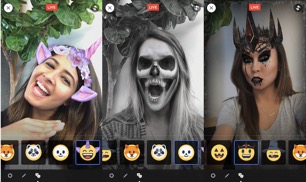On Wednesday, March 1st, Instagram opened up its Stories ad platform to brands of any size. This update is the latest challenge in the ongoing competition for mobile eyes and ad dollars between Instagram and Snapchat. But we need to stop and ask ourselves: are they even playing the same game? Did the recent implementation of Stories on Instagram, WhatsApp, and Messenger put a major dent in Snapchat’s trajectory? Or did this introduction of Stories unintentionally help springboard the new entertainment “TV” focused era for Snapchat? The platform shifts in the last six months bring serious questions to the long-term viability of Snapchat as a platform but also expose new areas of growth.
Instagram Makes a Statement
2016 was a year of drastic change for Instagram. It was also the year Instagram put Snapchat as we know it “on notice.” Depending on whose side you’re on, you may think of Instagram as the once pristine, independent, and inspirational photo-sharing app turned conglomerate copycat of the ephemeral, intimate, private, “cool” Snapchat. Conversely, you might believe Instagram is the leading visual communication platform, and they are adapting to changes in user behavior, while still doing it better than their competitors. I believe it is the latter.
In an attempt to bring the personal back to the platform, Instagram implemented numerous updates that range from small enhancements, such as adding the ability to bookmark posts, to more major updates, like live streaming, Instagram Stories, and enhanced direct messaging.
Many of these updates are a direct response to a growing Snapchat threat. Those moves appeared to have paid off, at least in the short term. According to documents from Snap’s IPO filing, Snapchat active user growth slowed 82% after the launch of Instagram stories.
As an advertiser, whether you think Instagram’s version of Stories is better than Snapchat’s Stories is irrelevant. In 2016, Instagram added 100 Million users in a single year, bringing their total users to 600 Million, and Instagram Stories now has nearly more users than Snapchat’s entire global platform.
According to Snapchat, Size Doesn’t Matter
In a recent exchange on Medium, two authors wrote competing viewpoints on how they see the future of Snapchat. The first, “Why I’m leaving Snapchat and so are all your friends” speaks to the utility of the platform, specifically how the updates to Instagram were enough to make him leave. The response, “Why I’m Not Leaving Snapchat, and My Friends Aren’t Either: A Response to Owen Williams’ Article” spoke about the platform’s emotional appeal, and how the intimacy, privacy, and secrecy of Snapchat is the true appeal, and how having a big following is not important. Snapchat used their IPO road show to convince investors of that exact same argument; spending significant time highlighting how the one-to-one, intimate communication with your closest friends is the user’s priority, and just because Snapchat is not the biggest does not mean they are not the best — emphasizing a smaller concentration of highly engaged users. (Tumblr anyone?)
Snapchat Needs to Evolve
Snapchat has always maintained that they are a camera company. It is the marketers and investors who continue attempting to classify Snapchat as one type of platform versus another. This gives Snapchat the opportunity to truly define their unique value proposition they will bring to the future.
To avoid the struggles that have plagued Twitter of the past few years and to survive the ongoing battle with Facebook, Snapchat needs to go back to their original challenge: creating an intimate viewing experience that is as appealing to users as it is advertisers. In other words, how can Snapchat turn the historically impersonal broadcast experience of TV into a personal, intimate consumption experience, at scale?
They Are Poised for Success, If They Do it Right
Coming out of the largest tech IPO since Facebook, with a market capitalization of $35 Billion, Snap Inc. is flush with cash and ready to make these sweeping changes on their own. Snapchat has always been something of an enigma for advertisers — it’s difficult to pinpoint what is driving users to the app.
Is it the disappearing photos? Is it the filters and lenses? Is it Discover, or Stories? Maybe that’s the appeal in and of itself. It’s flexible. It serves many functions, for many people, as a mobile-first, media-centric, conversation tool. There have been new apps that have tried to replicate each of those separate features, and failed. So far, Instagram has been the only one that appears to be making an impact.
Mobile devices have forced platforms to specialize in the offerings that they provide. Facebook is firmly entrenched as the multi-purpose platform that often finds itself as the main portal to the Internet for many users. Snapchat needs to celebrate their unprecedented media consumption experiences within Live Stories and Discover content, while supplementing their hardware products with unique augmented reality experiences.
My “aha moment” for the platform’s potential with Live Stories was when I was watching the NBA playoff on Live Stories. You get to watch the game from the sidelines, from the nose-bleeds, from the couch or even from the locker room. Snapchat is bringing a powerfully immersive and unique experience to what is otherwise passive observation, all in one mobile-first feed.
One of the biggest and most important changes we’ll see on the platform in the coming months will focus on the multiple TV network deals to create Snapchat specific content. As the TV landscape becomes more fragmented and app based, Snapchat’s grasp on the coveted 18-34 demographic sets them up to bring younger eyes back to “TV”.
In addition to Live Stories, Snapchat is one of the pioneering platforms to bring scale to augmented reality. So far, their use of AR has been fairly novel, specifically with the introduction of World Lenses, which flip the camera to allow you to go from looking like a dog, to becoming the dog. However, their numerous acquisitions of smart glass, 3D-Capture, facial recognition, and VR hardware companies has demonstrated their commitment to providing accessibility to augmented reality. They have also begun merchandising their augmented reality capabilities, with the introduction of Spectacles. Leveraging their current software and hardware functionality, they are in a position to make a big splash in the AR/VR world in 2017.
Lastly, Snapchat has made dramatic updates to their advertising capabilities within the app itself. At the end of January, Snapchat opened up their ads API to let brands buy on their own. They’ve made partnerships with measurement, viewability and sales tracking companies to prove their effectiveness, and they have enhanced their targeting capabilities to include behavioral and purchasing targeting. Those updates, combined with enhanced 360 viewing experiences, to potentially using AR to revolutionize billboards, indicate that Snapchat has rapidly matured into a substantial advertising platform.
But What About Lenses?
Until this point, you may have noted my lack of discussion of Snapchat Lenses, which remain Snapchat’s last unique product offering. Even with the impending ability to target lenses to specific audiences, my response is “meh.” Facebook acquired MSQRD early last year, and the infusion of “Facebook Masks” into all Facebook properties is inevitable. That being said, the addition of Facebook Masks will lead to a decrease in price point for Snapchat Lenses.
In Summary
The many developments over the past few months have many wondering if Instagram Stories has put the kibosh on Snapchat, calling into question the long-term viability of the platform. But no one platform can own a feature (Facebook did not have a News Feed for its first two years). A platform can own a purpose.
Snapchat is just getting started and they offer a unique video immersion experience like we’ve never had before. They’re taking the Facebook route to “TV” faster than Facebook did, and they are entering into the next wave of AR/VR experiences. If they can successfully turn the historically impersonal broadcast experience of TV into a personal, intimate consumption experience, at scale, Snapchat is poised for a successful future.




